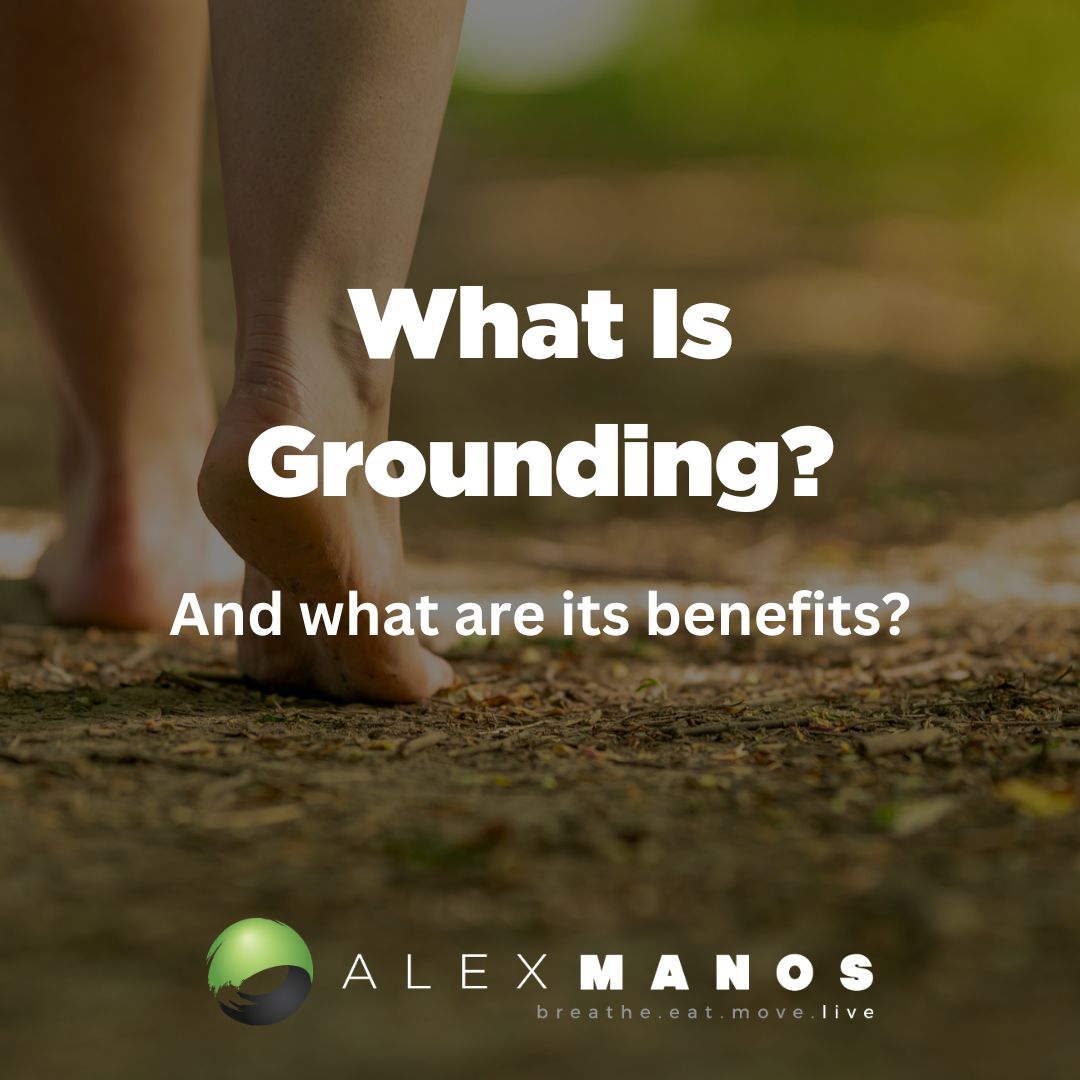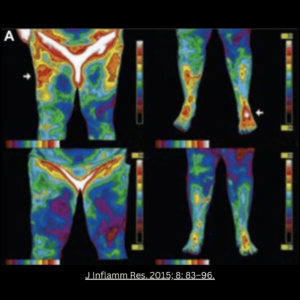Welcome to my blog post ‘Earthing The Most Important Health Discovery Ever?’.
You may also be interested in the section of my blog dedicated to biohacking, click here, in particular:
- What Are The Health Benefits Of Cold Exposure
- Psychobiotics: Probiotics For Mood And Mental Health
- Optimise Health With Sauna Therapy At Home
“There is something basic that has the potential to relieve much of the modern chronic disease crisis! I shall suggest that grounding or earthing is poised to be the equivalent of lemons and limes in terms of chronic and autoimmune diseases – a simple solution to a huge and escalating and drastically expensive set of problems. The solution is as close as the earth under our feet! Feedback from around the world has convinced earthing researchers that many people are suffering from a new deficiency disorder that could be termed “electron deficiency” caused by loss of contact with the surface of the Earth, with its abundant mobile electrons, which are nature’s original and best antioxidants.’ (source)
The above quote comes from Biomed Journal and was published last year (2023).
I have a growing concern that the health and fitness industry is guiding us further and further away from the truth. There are many layers, there is no one truth, but the truth I am referring to here is that nature heals. We are part of this planet, this universe, and a big reason for the health epidemics we see is due to a total disconnection from this truth. There’s a reason why so many people feel better on holiday – and a reduction in stress in only one factor. Often we are eating more locally (and perhaps in season), oftentimes we are grounding (at least beach holidays!), oftentimes we are outside MUCH more.
Throughout our evolutionary history, humans have walked barefoot on the earth or with leather soled shoes or moccasins that are electrically conductive. And we slept either directly on the earth or on electrically conductive animal hides. With the beginning of the age of plastics, around 1950, we began wearing shoes made of non-conductive materials – plastic, and rubber.
In an award-winning film, Clint Ober stated emphatically that insulating shoes were one of the worst inventions ever. (source)
Check our my recommend products under the section ‘Recommended Grounding Systems’.
What Is Earthing Or Grounding?
Grounding, also referred to as earthing, refers to direct skin contact with the surface of the Earth, such as with bare feet or hands, or with various grounding systems (more on these grounding systems below).
A brilliant book on the topic can be found on Amazon here.
The disconnection from the Earth may be an important, insidious, and overlooked contribution to physiological dysfunction and to the alarming global rise in non-communicable, inflammatory-related chronic diseases. (source)
Earthing The Most Important Health Discovery Ever
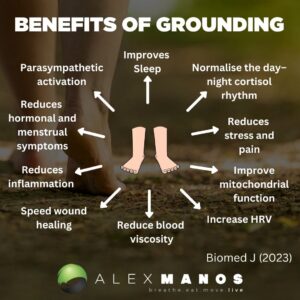
Anecdotal reports that walking barefoot on the Earth enhances health and provides feelings of well-being can be found in the literature and practices of diverse cultures from around the world.
However, recently, researchers have been studying the physiological effects of grounding from a variety of perspectives. This research has led to more than a dozen studies published in peer-reviewed journals. The research has opened a new and promising frontier in inflammation research.
Grounding reduces or even prevents the cardinal signs of inflammation following injury: redness, heat, swelling, pain, and loss of function. Rapid resolution of painful chronic inflammation was confirmed in 20 case studies using medical infrared imaging.
As well as having anti-inflammatory benefit grounding appears to:
- Improve sleep
- Normalise the day–night cortisol rhythm
- Reduce pain
- Reduce stress
- Shift the autonomic nervous system from sympathetic toward parasympathetic activation
- Increase heart rate variability
- Speed wound healing
- Reduce blood viscosity
- Anti-ageing
- Improve mitochondrial function and thus energy
These findings indicate that mitochondria in the grounded subjects are not producing as much metabolic energy, probably because there is less demand due to more rapid achievement of homeostasis
Let’s look at some of the benefits of grounding/earthing in a little more detail.
Earthing And The Immune System
Specifically, grounding an organism produces measurable differences in the concentrations of white blood cells, cytokines, and other molecules involved in the inflammatory response. (source)
Grounding reduces pain and alters the numbers of circulating neutrophils and lymphocytes, and also affects various circulating chemical factors related to inflammation (source).
Panel A shows reduction in inflammation from sleeping grounded (top vs bottom). Medical infrared imaging shows warm and painful areas (arrows in upper part of panel A). Sleeping grounded for 4 nights resolved the pain, and the hot areas cooled. Note the significant reduction in inflammation and a return toward normal thermal symmetry. (source)
Earthing And Sleep Benefits
One of the first published grounding studies examined the effects of grounding on sleep and circadian cortisol profiles. The study involved 12 subjects who were in pain and had problems sleeping. They slept grounded for 8 weeks using a grounding system. During this period, their diurnal cortisol profiles normalized, and most of the subjects reported that their sleep improved and their pain and stress levels declined.
The results of the experiment led to these conclusions:
- Grounding the body during sleep yields quantifiable changes in diurnal or circadian cortisol secretion levels that, in turn…
- Produce changes in sleep, pain, and stress (anxiety, depression, and irritability), as measured by subjective reporting.
The cortisol effects described by Ghaly and Teplitz are particularly significant in the light of recent research showing that prolonged chronic stress results in glucocorticoid receptor resistance. Such resistance results in failure to downregulate inflammatory responses, which can thereby increase risks of a variety of chronic diseases. (source)
Earthing And Longevity
Since the dominant theory of aging emphasises cumulative damage caused by ROS produced during normal metabolism or produced in response to pollutants, poisons, or injury, it can be hypothesises that grounding may positively influence longevity, and more importantly health span.
Researchers have hypothesised an anti-aging effect of grounding that is based on a living matrix (more on the living matrix below) reaching every part of the body and that is capable of delivering antioxidant electrons to sites where tissue integrity might be compromised by reactive oxidants from any source. (source)
Earthing And Pain Reduction
A pilot study on the effects of grounding on pain and the immune response to injury employed delayed-onset muscle soreness (DOMS). DOMS is the muscular pain and stiffness that takes place hours to days after strenuous and unfamiliar exercise.
Eight healthy subjects performed an unfamiliar, eccentric exercise that led to pain in their calf muscles. This was done by having them perform two sets of 20 toe raises with a barbell on their shoulders and the balls of their feet on a 2-inch × 4-inch wooden board.
All subjects ate standardised meals at the same time of day, and adhered to the same sleep cycle for 3 days. At 5.40 pm on each day, four of the subjects had conductive grounding patches adhered to their gastrocnemius muscles and the bottoms of their feet. They rested and slept on ground- ing systems such as that shown in Figure 4. They remained on the grounded sheets except for visits to the bathroom and meals. As controls, four subjects followed the same protocol except that their patches and sheets were not grounded.
The following measurements were taken before the exercise and 1, 2, and 3 days thereafter: pain levels, magnetic resonance imaging, spectroscopy, cortisol in serum and saliva, blood and enzyme chemistry, and blood cell counts.
Pain was monitored with two techniques. The subjective method involved morning and afternoon use of a Visual Analog Scale. In the afternoon, a blood pressure cuff was positioned on the right gastrocnemius and inflated to the point of acute discomfort. The pain was documented in terms of the highest pressures that could be tolerated. The grounded subjects experienced less pain, as revealed with both the analog soreness scale and by their ability to tolerate a higher pressure from the blood pressure cuff.
The DOMS grounding study report contains a summary of the literature on the changes in blood chemistry and content of formed elements (erythrocytes, leukocytes, and platelets) expected after an injury. The immune system detects pathogens and tissue damage and responds by initiating the inflammation cascade, sending neutrophils and lymphocytes into the region. As expected, the white cell counts increased in the ungrounded or control subjects. White cell counts in the grounded subjects steadily decreased following the injury.
Previous research has shown increases in neutrophils following injury. This happened in both grounded and ungrounded subjects, although neutrophil counts were always lower in the grounded subjects.
As the number of neutrophils increases, lymphocytes are expected to decrease. In the DOMS study, the lymphocyte count in the grounded subjects was always below the ungrounded subjects.
Normally, neutrophils rapidly invade an injured region, in order to break down damaged cells and send signals through the cytokine network to regulate the repair process. Neutrophils’ production of ROS and reactive nitro- gen species (RNS) is termed the “oxidative burst”. While ROS clear pathogens and cellular debris so that the tissue can regenerate, ROS can also damage healthy cells adjacent to the repair field, causing so-called collateral damage. The fact that the grounded subjects had fewer circulating neutrophils and lymphocytes could indicate that the original damage resolved more quickly, collateral damage reduced, and the recovery process accelerated.
Earthing And Cardiovascular Disease
“On the basis of the research described here we believe it would be beneficial for those who respond to traumatic accidents or to severe cardiovascular issues apply Earthing to their patients as soon as practicable, and, if possible, provide continuous grounding during recovery.”
Blood viscosity and aggregation are major factors in hypertension and other cardiovascular pathologies, including myocardial infarction. Cardiologists are gradually losing interest in low-density lipoprotein (LDL) cholesterol as the major cardiovascular risk factor. From the perspective of the health care practitioner, it is essential to have a better understanding of the relationships between other well-documented factors in CVD, including blood viscosity, blood pressure (BP), peripheral resistance, coagulation, left-ventricular hypertrophy, and inflammation. (source)
Grounding increases the surface charge on RBCs and thereby reduces blood viscosity and clumping. Grounding appears to be one of the simplest and yet most profound interventions for helping reduce cardiovascular risk and cardiovascular events. (source).
Blood is a complex fluid containing a variety of formed elements (cells), proteins, nutrients, and metabolic waste products, along with dozens of clotting factors. In spite of this complexity, measurement of the electrophoretic mobility or zeta potential of red blood cells (RBCs) is a simple method for measuring blood viscosity. This is because blood viscosity is strongly influenced by the RBC surface charge that governs the spacing between erythrocytes. A higher repulsive surface charge increases spacing between erythrocytes, reduces clumping, lowers viscosity, and lowers peripheral resistance to flow. Conditions that reduce RBC surface charge correlate with occlusive arterial disease because of a higher incidence of RBC aggregation.
It is accepted that blood viscosity and resistance to blood flow are related and are elevated in patients who have hypertension. Total resistance is the product of vascular resistance and viscosity. Small changes in viscosity produce large differences in total resistance, especially in peripheral vessels <30 μm in diameter, in which the relative effective viscosity can increase six- to sevenfold. These results confirm the existence of a blood hyperviscosity syndrome in hypertension.
A meta-analysis evaluating the connection between blood viscosity and CVD demonstrates clearly that the risk of major cardiovascular events increase with higher blood-viscosity levels. In the Edinburgh Artery Study, a population of 4860 men 45–59 years of age was observed for 5 years. The 20% of the men with the highest blood viscosity had a 3.2 times greater risk for cardiac events, compared with the 20% of men with the lowest blood viscosity. Fifty-five percent (55%) of major cardiovascular events occurred in the highest blood-viscosity group versus only 4% in the lowest blood-viscosity group.
Earthing And Blood Pressure
In another small clinical investigation, earthing and grounding effects were studied on hypertensive individuals. There were ten participants in the study, all of whom were on one to three anti-hypertensive drugs. All ten patients reduced their blood pressure and many were able to reduce their reliance on hypertensive blood pressure medication. Systolic blood pressure levels decreased 8.6%–22.7% with an average reduction of 14.3%. The pilot study clearly demonstrated that grounding for a minimum of ten to 12 h per day resulted in remarkable blood pressure lowering. (source)
Earthing Supports Energy Production
The search for evidence-based improvements in reducing human suffering without significant risk will continue in the healing profession. Grounding provides a primary source of cellular restoration and energy by supporting the mitochondria or the microscopic power plants that literally provide energy to the cell. (source)
Although oxygen is essential to metabolism and life, the oxygen molecule itself is extremely toxic and the body uses a variety of antioxidant processes to keep the concentration of oxygen low in the tissues. Too much oxygen creates oxidative stress. One of the key reactions in living cells, of course, is the electron transport chain in mitochondria that produces adenosine triphosphate (ATP), the energy source for all living processes. Studies have shown that providing electrons to animals dramatically increases ATP production and protein synthesis, 2 processes that are essential for wound healing. (source)
Electrons from earth serve as a potent neutralizer or quencher of electron-seeking free radicals. The term electron deficiency may be appropriate to describe the largely ungrounded status of most of humanity. As noted, the modern lifestyle, notably the wearing of shoes with synthetic soles, has severed us from our electric roots, our connection with earth and its natural supply of electrons. (source)
Earthing may perhaps be a way to transfer electrons and fortify mitochondria, thus contributing to optimum levels of ATP production in our cells. (source)
Earthing And COVID-19
Mousa reported out of the University of Basrah College of Medicine in Iraq an observational study on 59 patients with confirmed Covid-19 infection. Earthing was carried out by the patients either walking barefoot on non-insulated ground or utilizing chest patches with a conductive metallic bar in the earth with conductive wire attached to an electrode (electrocardiography-type patch) over each lung. In the patients that were grounded, the complication of blood clots was not seen as opposed to the patients that were not grounded. After 1–3 days of grounding, most patients experienced improvement in fever, dyspnea, cough, weakness, headache, chest pain, body pain and even taste and smell loss. (source)
Twenty patients of the 59 had severe illness and 17 improved, two were lost in follow-up and one expired. In 28 with moderate illness, all improved; and in 11 with mild illness, all improved and no deaths were reported. Mousa concluded that grounding demonstrated significant preventative as well as curative aspects in the treatment of Covid-19.
How Does Earthing Or Grounding Work?
Everything [in the human body] is electric. This seemingly simple observation has transformational repercussions on the way we think about and approach physical, mental, and emotional health. (source)
The Earth’s surface is electrically conductive and is maintained at a negative potential by a global electrical circuit. This circuit has three main generators; the solar wind entering the magnetosphere; the ionospheric wind; and thunderstorms. An estimated 1000–2000 thunderstorms are continually active around the globe, emitting thousands of lightening strikes per minute. This creates a constant current of thousands of amperes transferring positive charge to the upper atmosphere and negative charge to the surface of the Earth. The Earth’s surface is therefore an abundant source of free electrons. As soil’s electrons are conducted to the human body, the grounded body assumes favourable physiologic and electrophysiologic changes. (source)
So the main hypothesis is that connecting the body to the Earth enables free electrons from the Earth’s surface to spread over and into the body, where they can have antioxidant effects. Specifically, it has been suggested that mobile electrons create an antioxidant microenvironment around the injury repair field, slowing or preventing reactive oxygen species (ROS) delivered by the oxidative burst from causing “collateral damage” to healthy tissue, and preventing or reducing the formation of the so-called “inflammatory barricade” (1).
It has also been hypothesised that electrons from the Earth may prevent or resolve so-called “silent” inflammation.
One route these electrons may take is via acupuncture points and meridians. The meridians are known to be ‘low resistance pathways’ for the flow of electrical currents. Another pathway proposed in the research is via the mucous membranes of the respiratory and digestive tracts, which are continuous with the skin surface.
Grounding And The Living Matrix
The living matrix is defined as the continuous molecular fabric of the organism, consisting of fascia, the other connective tissues, extracellular matrices, integrins, cytoskeletons, nuclear matrices and DNA. (source)
It constitutes a body-wide reservoir of charge that can maintain electrical homeostasis and “inflammatory preparedness” throughout the organism.
Research in cell biology and biophysics reveals the human body is equipped with a system-wide collagenous, liquid–crystalline semiconductor network known as the living matrix, or in other terms, a ground regulation system or tissue tensegrity matrix system. This body-wide network can deliver mobile electrons to any part of the body and thereby routinely protect all cells, tissues, and organs from oxidative stress or in the event of injury.
The living matrix includes the extracellular and connective tissue matrices as well as the cytoskeletons of all cells. Integrins at cell surfaces are thought to allow for semi-conduction of electrons to the cell interior, and links across the nuclear envelope enable the nuclear matrix and genetic material to be part of the circuitry.
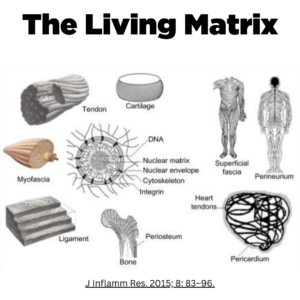
The hypothesis of the authors of the paper (source) is that this body-wide electronic circuit represents a primary antioxidant defence system.
It is not widely appreciated that collagen and other structural proteins are semiconductors. This concept was introduced by Albert Szent-Györgyi in the Korányi memorial lecture in Budapest, Hungary in 1941. His talk was published in both Science (Towards a New Biochemistry?) and Nature (The Study of Energy Levels in Biochemistry). The concept that proteins might be semiconductors was immediately rejected by biochemists. Many modern scientists continue to reject semi-conduction in proteins, because living systems only have trace amounts of silicone, germanium, and compounds of gallium that are the most widely used materials in electronic semiconductor devices. However, there are many ways of making organic semiconductors without using metals. (source)
One of the sources of confusion was the widely held belief that water was a mere filler material. We now know that water plays crucial roles in enzymatic activities and semi-conduction. Hydrated proteins actually are semiconductors, and have become important components in the global microelectronics industry. Organic microcircuits are preferred for some applications, because they can be made very small, self-assemble, are robust, and have low energy consumption. (source)
Ground substance polyelectrolyte molecules associated with the collagenous connective tissue matrix are charge reservoirs. The matrix is therefore a vast whole-body redox system. The glycosaminoglycans have a high density of negative charges due to the sulfate and carboxylate groups on the uronic acid residues. The matrix is therefore a body-wide system capable of absorbing and donating electrons wherever they are needed to support immune functioning. The interiors of cells including the nuclear matrix and DNA are all parts of this biophysical electrical storage and delivery system. The time-course of the effects of grounding on injury repair can be estimated in various ways. (source)
First, we know from medical infrared imaging that inflammation begins to subside within 30 minutes of connecting with the earth via a conductive patch placed on the skin.
Secondly, metabolic activity increases during this same period. Specifically, there is an increase in oxygen consumption, pulse rate, and respiratory rate and a decrease in blood oxygenation during 40 minutes of grounding. We suspect that the “filling” of the charge reservoirs is a gradual process, possibly because of the enormous number of charged residues on the polyelectrolytes, and because they are located throughout the body. When charge reservoirs are saturated, the body is in a state we refer to as “inflammatory preparedness”. This means that the ground substance, which pervades every part of the body, is ready to quickly deliver antioxidant electrons to any site of injury via the semiconducting collagenous matrix. (source)
The crucial piece of evidence that gave rise to the living matrix concept was the discovery that the molecular fabrics within all cells, the cytoskeletons, are mechanically and energetically connected across cell surfaces to the surrounding extracellular connective tissue system. (source)
The matrix and the importance in electron flow helps explain how bodywork and movement therapies can facilitate the resolution of acute or chronic injuries, and how patients with inflammatory conditions may “deplete” a therapist during hands-on treatments. It is suggested that barefoot contact with the earth as well as hands-on and hands-off therapies facilitate healing by stimulating the migration of charges into sites of acute or chronic inflammation (source)
Recommended Grounding Systems
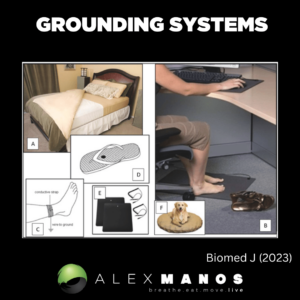
We can’t spend all day and night connected with the earth, but grounding systems make this much more possible. Grounding systems include grounding bed sheets, grounding shoes and sandals, and grounding mats which you can place under your desk.
I use ALL of these.
The electrical circuits in modern homes have a grounding system directly connected to a metal rod driven into the earth. This means that every room in a modern dwelling has a readily available connection to the earth. These grounding terminals are especially important for those suffering from a chronic disease, autoimmune disorder, physical trauma, or chronic pain, as they will likely benefit from having their bodies connected to the earth throughout the day and night. (source)
Learn more by watching my interview with Carrie Bennett.
What Is An Earthing Mat?
Various grounding systems are available that enable frequent contact with the Earth, such as while sleeping, sitting at a computer, or walking outdoors. These are simple conductive systems in the form of sheets, mats, wrist or ankle bands, adhesive patches that can be used inside the home or office, and footwear.
These applications are connected to the Earth via a cord inserted into a grounded wall outlet. For the footwear applications, a conductive plug is positioned in the shoe sole at the ball of the foot, under the metatarsals, at the acupuncture point known as Kidney 1.
From a practical standpoint, these methods offer a convenient and routine, user-friendly approach to grounding or earthing. They can also be used in clinical situations.
Earthing/Grounding: The Most Powerful Antioxidant
Modern lifestyle factors such as insulating footwear, high-rise buildings, and elevated beds separate most humans from direct skin connection with the Earth’s surface.
An earth connection was an everyday reality in past cultures that used animal skins for footwear and to sleep on.
Researchers suggest that ‘the process of killing pathogens and clearing cellular debris from injury sites evolved to take advantage of the body’s constant access to the virtually limitless source of mobile electrons the Earth provides when we are in contact with it.’
Antioxidants are electron donors, and the best electron donor, we strongly believe, is right under our feet: the surface of the Earth, with its virtually unlimited storehouse of accessible electrons.
Electrons from the Earth may in fact be the best antioxidants, with zero negative secondary effects, because our body evolved to use them over eons of physical contact with the ground.
Our immune systems work beautifully as long as electrons are available to balance the reactive oxygen species (unstable molecules) used when dealing with infection and tissue injury. Our modern lifestyle has taken the body and the immune system by surprise by suddenly depriving it of its primordial electron source. This planetary separation began accelerating in the early 1950s with the advent of shoes made with insulating soles instead of the traditional leather.
The disconnection from the Earth may be an important, insidious, and overlooked contribution to physiological dysfunction and to the alarming global rise in non-communicable, inflammatory-related chronic diseases.
A lack of electrons can also de-saturate the electron transport chains in mitochondria (where energy is created) , leading to chronic fatigue and slowing the cellular migrations and other essential activities of the cells of the immune system.
Summary:
Grounding is a simple, natural, and accessible health strategy against chronic inflammation, warranting the serious attention of clinicians and researchers.
The living matrix (or ground regulation or tissue tensegrity-matrix system), the very fabric of the body, appears to serve as one of our primary antioxidant defense systems. As this report explains, it is a system requiring occasional recharging by conductive contact with the Earth’s surface – the “battery” for all planetary life – to be optimally effective..
References:
- The effects of grounding (earthing) on inflammation, the immune response, wound healing, and prevention and treatment of chronic inflammatory and autoimmune diseases: click here.
- Earthing: Health Implications of Reconnecting the Human Body to the Earth’s Surface Electrons: click here.
- Earthing the human body influences physiologic processes: click here.
- The neuromodulative role of earthing: click here.
- Integrative and lifestyle medicine strategies should include Earthing (grounding): Review of research evidence and clinical observations: click here.
- The Effects of Grounding (Earthing) on Bodyworkers’ Pain and Overall Quality of Life: A Randomized Controlled Trial: click here.
- Earthing (grounding) the human body reduces blood viscosity-a major factor in cardiovascular disease: click here.
- Electric Nutrition: The Surprising Health and Healing Benefits of Biological Grounding (Earthing): click here.
- Grounding after moderate eccentric contractions reduces muscle damage: click here.
- Effectiveness of Grounded Sleeping on Recovery After Intensive Eccentric Muscle Loading: click here.
- Pilot study on the effect of grounding on delayed-onset muscle soreness: click here.
- The biologic effects of grounding the human body during sleep as measured by cortisol levels and subjective reporting of sleep, pain, and stress: click here.
- Earthing the human body influences physiologic processes: click here.
Alex is a certified Functional Medicine Practitioner (IFMCP) and has a MSc in Personalised Nutrition. He is also a breathwork facilitator with a background in personal training and massage therapy. He also runs The Resiliency Program - a 24 week program aimed at building physical, mental, emotional, and spiritual resilience.

